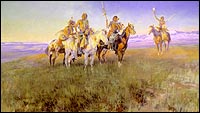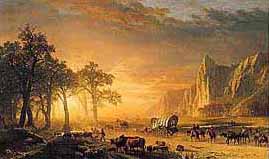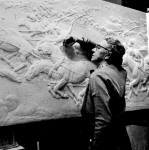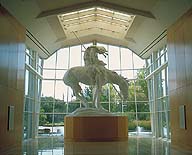Subject:
Cowboys and Indians.
Date: Sun,
14 Sep 1997 08:25:46 -0700
00:16 Council
Road RV; Oklahoma City, Oklahoma :: 14 SEP 97
[A few displays found in the National Cowboy Hall of Fame (along
with my inevitable comments).]
~~~~~~~~~~~~~~~~~~~~~
[An illustrated letter: The letterhead appears as below, beneath
a buffalo skull which Russell also uses with his initials to sign his
work. In pen and ink is illustrated a scene of two American Indian men
on horseback, each carrying a spear. The illustration is dated March 10,
1920.]
C. M. Russell
GREAT FALLS, MONTANA
Charles F. Lunnis
I have Eaten and Smoked in your camp and as our wild brothers
would. I call you Friend. Time only changes the outside of things. it
scars the rock and snarles the tree but the heart inside is the same.
In your youth you loved wild things. Time has taken them and given you
much dont want. Your body is here in a highley civilized land but your
heart lives on the back trails that are grass grown and plowed under.
If the cogs of time would slip back seventy winters you wouldn't be
long. Shedding to a breech cloth and mocassins-and instead of being
holed up in a man made valley-you'd be tailing with a band of Navajoes
headed for the buffalo range. I heap savy you caus thaird be another
White Injun among the Blackfeet hunting hump backed cows.
My brother, when you come to my lodge the robe will be spread
and the pipe lit for you. I have said it.
Your friend C M Russell
~~~~~~~~~~~~~~~~~~~~~
[Excerpts from a biographical blurb accompanying the museum's
large Russell collection.]
Charles M. Russell is probably the most loved artist of the
West. Born in 1864, he grew up in an affluent St. Louis suburb and moved
to Montana when he was just sixteen, fully immersing himself in the
life of the West...
Russell's art changed toward the end of his career. Early
in his life, as both cowboy and an artist, he tended to paint scenes
that he saw probably hundreds of times-the daily routine of ranch life.
He had a deep respect and affinity for Native Americans and his early
works often depicted them engaged in the activities of their daily lives.
Increasingly though, toward the end of his life, he concentrated his
talent on depictions of Western life, primarily Native American life,
that happened long before he arrived on the scene. He lamented the passing
of the old ways of the West and projected those feelings onto his canvasses.
"Red Man's Wireless," which depicts Native Americans just after the
intrusion of the white man on the Northern Plains, is a prime example
of that interest.

Red Man's Wireless
C M Russell
[Red Man's Wireless shows four Native Americans on horse back,
one holding aloft a mirror which is being used as a signal reflector in
the light of the setting sun. Of course, Russell hankered after a past
that to some extent never existed. One painting, "Before the White Man
Came," oil on canvas 1897, romantically depicts three Native American
horsemen, one shading his eyes as he peers into the setting sun that casts
a light amber glow. Problem is, before the White Man there were no horses
to be found on the American continents...unless Russell excludes the Spanish,
who introduced them, from the label, "White men."]
~~~~~~~~~~~~~~~~~~~~~

The Oregon Trail
Albert Bierstadt
1867
Albert Bierstadt's epic painting of settlers heading into the
sunset serves as a metaphor for the way many nineteenth century Americans
viewed the West. It was a land of promise, a place of new beginnings
where dreams could be fulfilled. An old way of life could be left behind,
much like the cast iron stove in the painting that has been abandoned
to lighten the load.
[Actually, the cast iron stove is broken in half and may have
been left behind due to its uselessness.]
~~~~~~~~~~~~~~~~~~~~~
 Oklahoma
Run
Oklahoma
Run
Laura Gardin Fraser 1889-1966
At high noon on April 22, 1889 over 50,000 homesteaders and
speculators raced to stake their claims on 1,800,000 acres of newly
opened land in the future state of Oklahoma. By nightfall, after one
of the most dramatic "land rushes" in American History, the new towns
of Oklahoma City and Guthrie each boasted more than 10,000 residents.
Conceived in 1953 as a monument to Oklahoman pioneers, this
is the working model for a planned 12-foot by 70-foot bas-relief sculpture
that was to be unveiled in Oklahoma city for the 50th anniversary of
statehood in 1957. Although this project never came to fruition a 20-foot
long casting in bronze of this model was placed in Oklahoma City's Bicentennial
Plaza in 1976.
[The 4-foot by 20-foot model shows a dense pack of riders, wagons
and coaches, head down in a mad dash.]
~~~~~~~~~~~~~~~~~~~~~

End of the Trail
 Lincoln
Lincoln
James Earl Fraser
During the early days of the Civil War, President Lincoln
often walked to a hill overlooking Washington to spend the twilight
hours in thought and meditation. Fraser's portrayal has Lincoln sitting
on a stone and gazing down on the troubled Capitol of the Union, his
shoulders revealing the burden of his office.
Considered a "western" president, Lincoln made remarkable
contributions to the settlement and development of the West even while
preoccupied by war. In May of 1862 he signed the Homestead Act into
law, permitting the unhindered ownership of farmland in the West by
more than one million farmers prior to 1910. This was followed by the
college land grant of July, 1862, which enabled the establishment of
institutions of higher learning in largely unsettled frontier states
and territories. Under his tutelage as well, the Railroad Land Grant
Acts of 1862 and 1864 were passed, laying the foundation for the transcontinental
routes and quickening the pace of western settlement.
~~~~~~~~~~~~~~~~~~~~~
[Neither of the previous two blurbs even alludes to the fact
that the process was more western displacement than western settlement.
The 1,800,000 acres of land simply "opened up" were treatied lands, belonging
to the Indians of the Indian Territory. These agreements were broken by
presidential proclamation. Many of the Indian peoples living in the Territory
had been forced to move there from previous land settlement by whites
in the Eastern states. Now they were forced to live on ever smaller reserves,
even to take their land cut up into small family plots, which was never
their way of land use which understood no sense of individual land ownership.
The West was not "largely unsettled" except that its white population
was rather sparse in comparison to the large Native American presence,
a multitude of cultures that had first settled the land thousands of years
before.
The National Cowboy Hall of Fame displays a large collection
of Indian art and artefacts but makes very little effort to present these
images in the context of how the creation of the cowboy through westward
expansion affected the Indians. There is ample opportunity to do so in
just the two previous blurbs. Even the CM Russell bit refers to the changes
confronting the Indians as the mere passing of time, and Russell says
that only the outside of things has changed but the heart remains the
same. I wonder if the Blackfoot to whom he addressed the letter agreed
with him on this point.
The Hall of Fame houses a large, beautiful and compelling set
of images. It's a shame the textual context it often sets for the images
tends toward such unimaginative romanticism.]
~~~ Responses Sought ~~~
He don't even like word writin'. Kinda scares I'm I
guess. Ever time Pa seen writin', somebody took somepin' away from 'im.